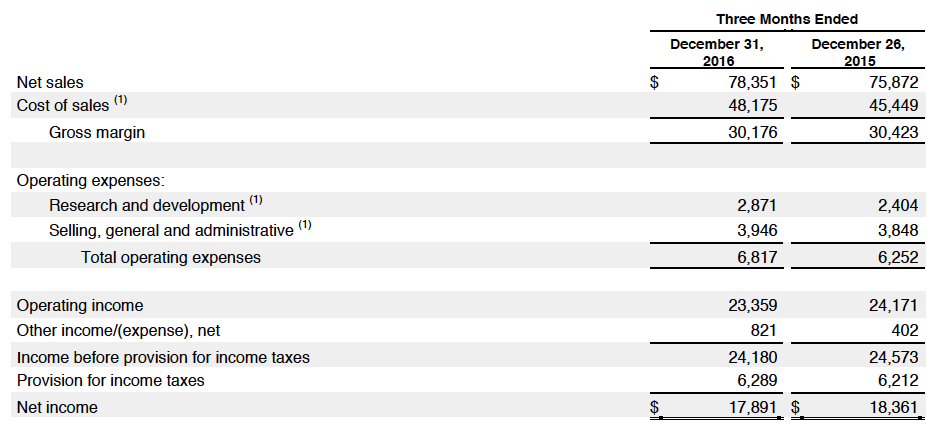It is not uncommon for investors to require monthly and/or quarterly financial reports. Unless the investor is an accountant, what they are expecting is rather simple.
Apple, well know for their simple industrial design, does just as good a job at designing their quarterly reports. Here’s their Q1 2017 report. One page of text summary, four pages of numbers, and then the obligatory disclaimer, as they are a public company.
Diving into their numbers, the key report most relevant to startups is the P&L statement, summarized into just 12 lines of values:

For your company, it may be important to split out the revenues from multiple products/service, and for your company it may be important to split out a few other expenses, but for an investor, this is sufficient detail to see if the company is profitable, how profitable, and with the second column to compare to, shows a hint of upward trend.
For public companies, it is normal to compare one quarter with the same quarter a year before. Many companies have seasonal sales, and thus the year-over-year change is more telling than the quarter-over-quarter change. For startups, the bets growth is month-over-month, so if this were Apple’s report from 1977 when it were still young, it would be helpful to have a four more columns, showing each of the last four quarters.
And for startups, businesses change quickly, and thus a monthly report in this form is useful to share with your investors too. In that case, a few more columns of prior months values would be great to see.
The other interesting report from Apple is below, focusing on growth in revenues, split out by region (and also by product). For startups, management should be focused on growing revenues (a.k.a. the top line), as well as keeping control over growth in expenses. This report does a nice a nice job of showing the growth rates quarter-by-quarter side and year-over-year.

For a startup, I’d love to see the total expenses listed on the next line, to see if the growth in expenses is keeping up with the growth in revenues, or whether the company is find a way to scale more efficiently.
Apple’s report include a balance sheet and cashflow statement. Personally, I spent 99% of my time focused on the P&L statement, as in nearly all cases startups should be using cash accounting, which puts everything but the bank balance on the P&L.
For my investments, I unfortunately know well in advance of any financial report when the bank balance runs low, as that is when the founders come calling for more money. But that is another lesson.










